from ESPN http://ift.tt/1dPqUAn
Final: Giants 13 Pirates 5. WP: SF J Cueto (6-7) LP: PIT G Cole (6-7) (ESPN)
from ESPN http://ift.tt/1dPqUAn
The ‘Face’ of Jupiter

JunoCam images aren’t just for art and science – sometimes they are processed to bring a chuckle. via NASA http://ift.tt/2u6EApm
NGC 7814: The Little Sombrero in Pegasus
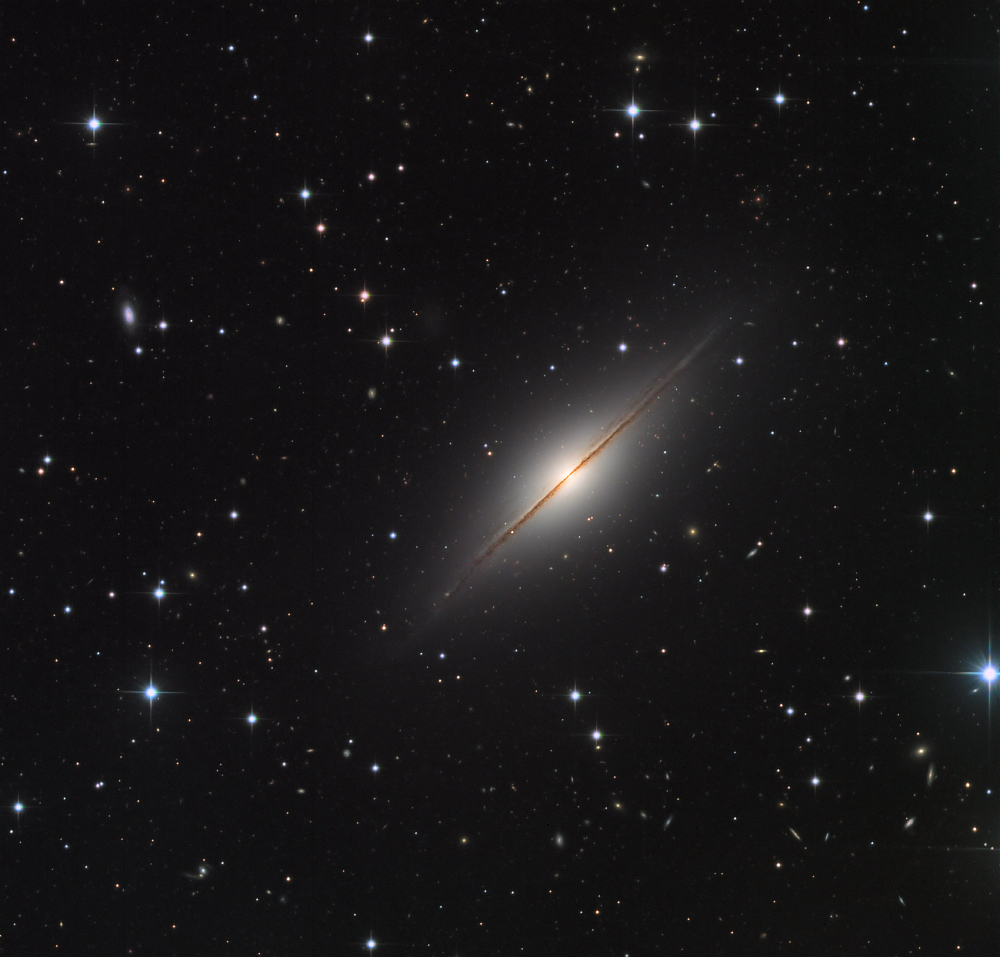
Point your telescope toward the high flying constellation Pegasus and you can find this expanse of Milky Way stars and distant galaxies. Dominated by NGC 7814, the pretty field of view would almost be covered by a full moon. NGC 7814 is sometimes called the Little Sombrero for its resemblance to the brighter more famous M104, the Sombrero Galaxy. Both Sombrero and Little Sombrero are spiral galaxies seen edge-on, and both have extensive halos and central bulges cut by a thin disk with thinner dust lanes in silhouette. In fact, NGC 7814 is some 40 million light-years away and an estimated 60,000 light-years across. That actually makes the Little Sombrero about the same physical size as its better known namesake, appearing smaller and fainter only because it is farther away. Very faint dwarf galaxies, potentially a satellites of NGC 7814, have been discovered in deep exposures of Little Sombrero. via NASA http://ift.tt/2tn1Cun
Starry Night and Aurora

Expedition 52 Flight Engineer Jack Fischer of NASA photographed the glowing nighttime lights of an aurora from his vantage point in the International Space Station's cupola module on June 19, 2017. Part of the station's solar array is also visible. via NASA http://ift.tt/2s5Udf4
Symbiotic R Aquarii
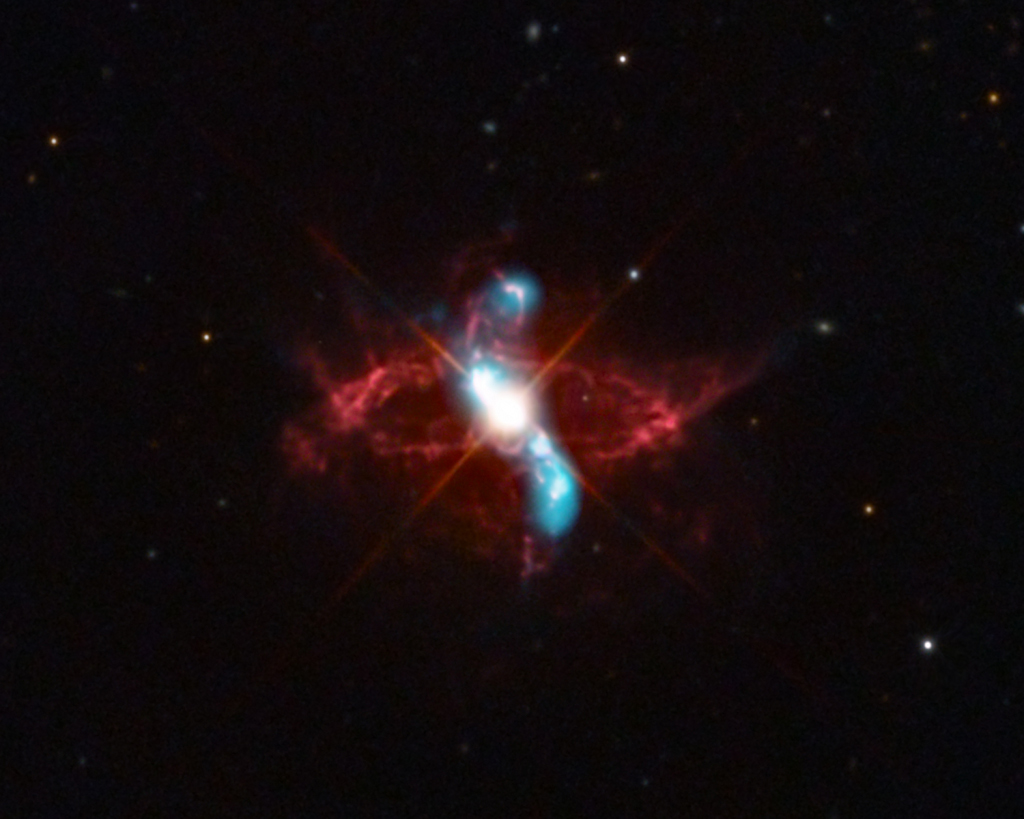
A long recognized naked-eye variable star, R Aquarii is actually an interacting binary star system, two stars that seem to have a close, symbiotic relationship. About 710 light years away, it consists of a cool red giant star and hot, dense white dwarf star in mutual orbit around their common center of mass. The binary system's visible light is dominated by the red giant, itself a Mira-type long period variable star. But material in cool giant star's extended envelope is pulled by gravity onto the surface of the smaller, denser white dwarf, eventually triggering a thermonuclear explosion and blasting material into space. Optical image data (red) shows the still expanding ring of debris originating from a blast that would have been seen in the early 1770s. The evolution of less understood energetic events producing high energy emission in the R Aquarii system has been monitored since 2000 using Chandra X-ray Observatory data (blue). The composite field of view is less that a light-year across at the estimated distance of R Aquarii. via NASA http://ift.tt/2tjifHw
Final: Giants 5 Rockies 3. WP: SF T Blach (5-5) LP: COL K Freeland (8-6) (ESPN)
from ESPN http://ift.tt/1dPqUAn
The Niagara Falls of Mars

Various researchers are often pre-occupied with the quest for flowing water on Mars. via NASA http://ift.tt/2shuEvD
Composite Messier 20 and 21
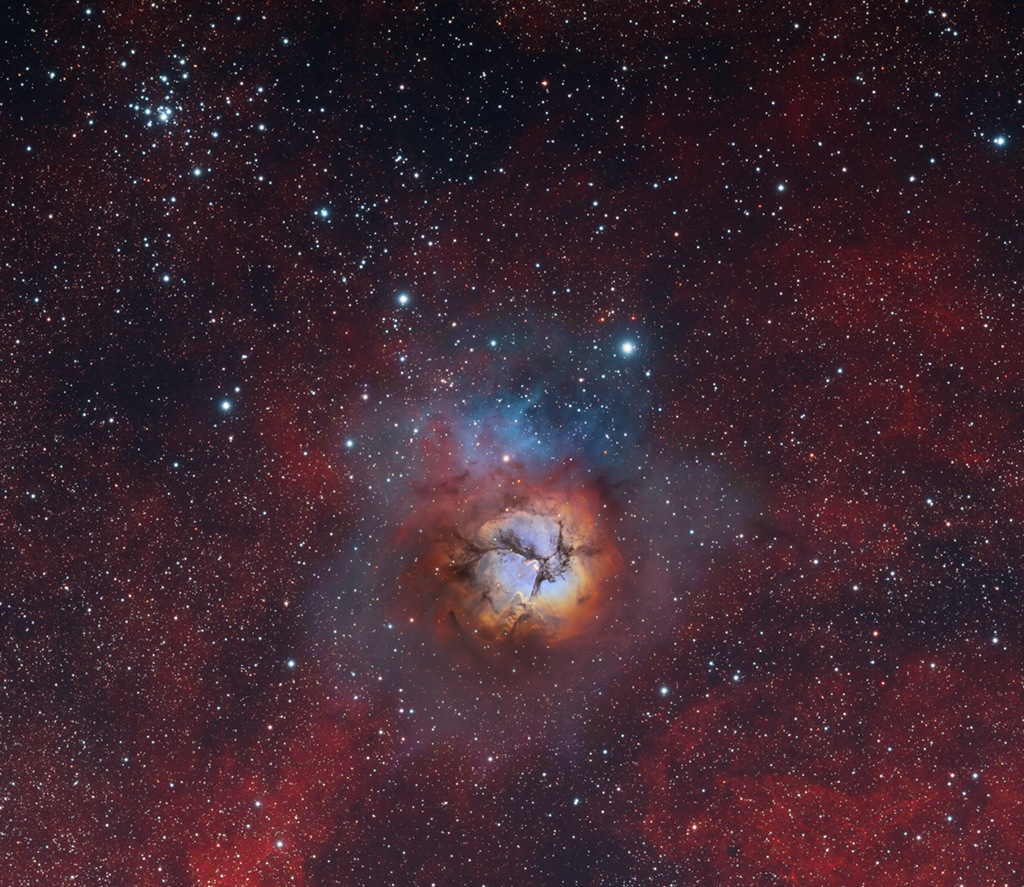
The beautiful Trifid Nebula, also known as Messier 20, lies about 5,000 light-years away, a colorful study in cosmic contrasts. It shares this nearly 1 degree wide field with open star cluster Messier 21 (top left). Trisected by dust lanes the Trifid itself is about 40 light-years across and a mere 300,000 years old. That makes it one of the youngest star forming regions in our sky, with newborn and embryonic stars embedded in its natal dust and gas clouds. Estimates of the distance to open star cluster M21 are similar to M20's, but though they share this gorgeous telescopic skyscape there is no apparent connection between the two. M21's stars are much older, about 8 million years old. M20 and M21 are easy to find with even a small telescope in the nebula rich constellation Sagittarius. In fact, this well-composed scene is a composite from two different telescopes. Using narrowband data it blends a high resolution image of M20 with a wider field image extending to M21. via NASA http://ift.tt/2tdOffI
As the Sun Rises, NASA's Global Hawk is Being Prepared for Flight

Hot summer days in Southern California’s Antelope Valley force many aircraft operations to start early in the morning before the sun rises. On a back ramp at Armstrong Flight Research Center on Edwards Air Force Base, a NASA Global Hawk goes through testing of its communication components and satellite connection links in preparation for flight. via NASA http://ift.tt/2sX9zUG
Final: Giants 9 Rockies 2. WP: SF J Samardzija (3-9) LP: COL G Marquez (5-4) (ESPN)
from ESPN http://ift.tt/1dPqUAn
The M81 Galaxy Group through the Integrated Flux Nebula
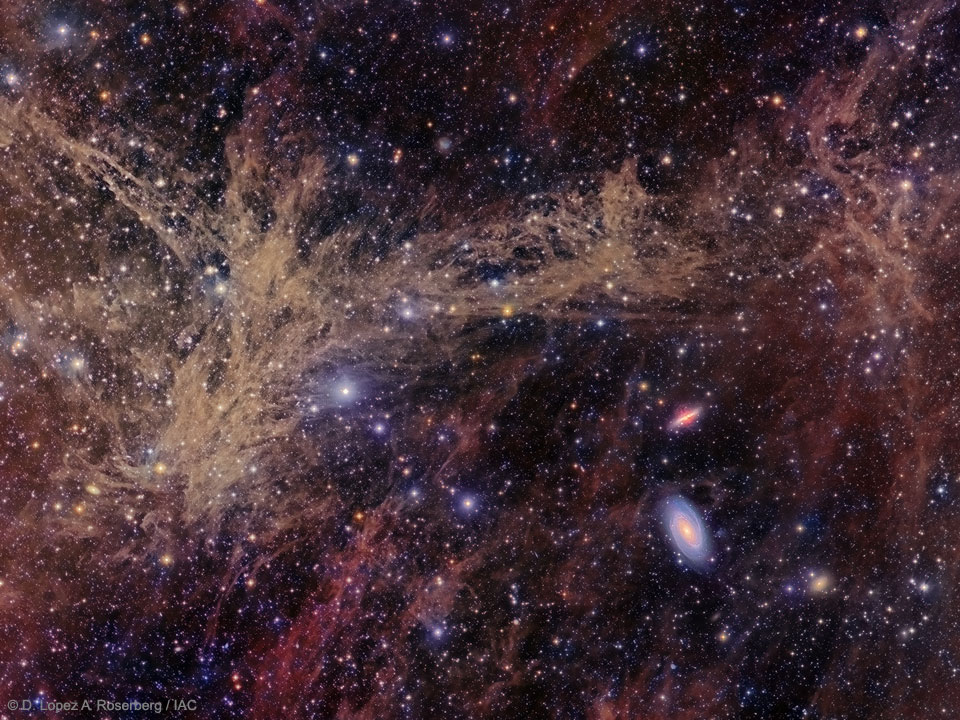
Distant galaxies and nearby nebulas highlight this deep image of the M81 Group of galaxies. First and foremost in this 80-exposure mosaic is the grand design spiral galaxy M81, the largest galaxy in the image, visible on the lower right. M81 is gravitationally interacting with M82 just above it, a large galaxy with an unusual halo of filamentary red-glowing gas. Around the image many other galaxies from the M81 Group of galaxies can be seen, as well as many foreground Milky Way stars. This whole galaxy menagerie is seen through the glow of an Integrated Flux Nebula (IFN), a vast and complex screen of diffuse gas and dust also in our Milky Way Galaxy. Details of the red and yellow IFN, digitally enhanced, were imaged by a new wide-field camera recently installed at the Teide Observatory in the Canary Islands of Spain. via NASA http://ift.tt/2t7WOsw
Saturnian Dawn

NASA's Cassini spacecraft peers toward a sliver of Saturn's sunlit atmosphere while the icy rings stretch across the foreground as a dark band. via NASA http://ift.tt/2sIzUaw
Artistic Impression: The Surface of TRAPPIST 1f
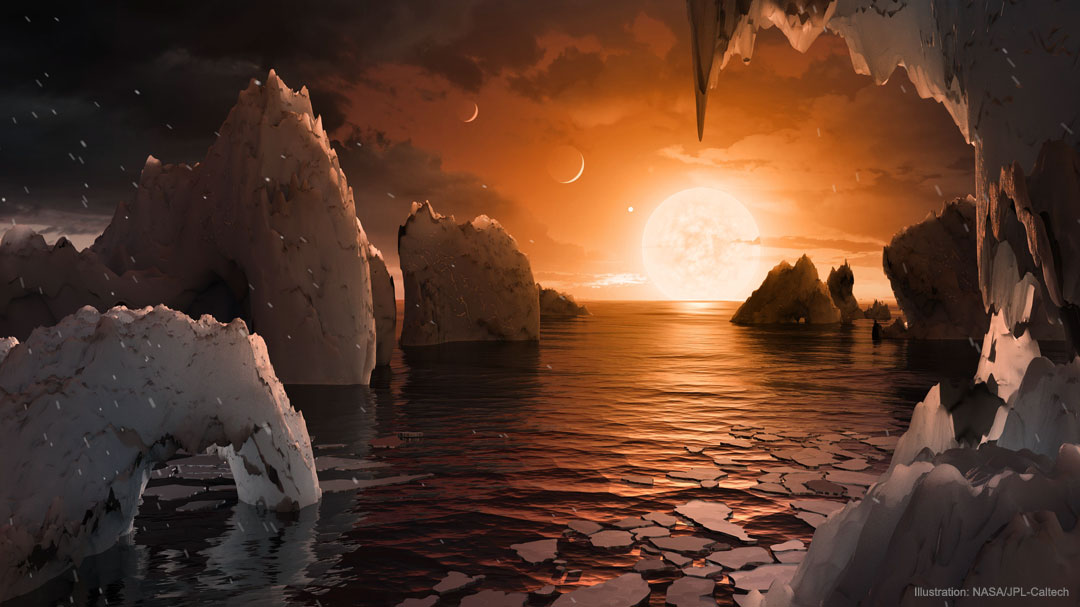
If you could stand on the surface of the newly discovered Earth-sized exoplanet TRAPPIST-1f, what would you see? Presently, no Earthling knows for sure, but the featured illustration depicts a reasoned guess based on observational data taken by NASA's Sun-orbiting Spitzer Space Telescope. In 2017, four more Earth-sized planets were found by Spitzer, including TRAPPIST-1f, in addition to three discovered in 2015 from the ground. From the planet's surface, near the mild terminator between night and day, you might see water, ice, and rock on the ground, while water-based clouds might hover above. Past the clouds, the small central star TRAPPIST-1 would appear more red than our Sun, but angularly larger due to the close orbit. With seven known Earth-sized planets -- many of which pass near each other -- the TRAPPIST-1 system is not only a candidate to have life, but intercommunicating life -- although a preliminary search has found no obvious transmissions. via NASA http://ift.tt/2u2C9mW
Final: Mets 8 Giants 2. WP: NYM R Montero (1-4) LP: SF M Moore (3-8) (ESPN)
from ESPN http://ift.tt/1dPqUAn
The N44 Superbubble
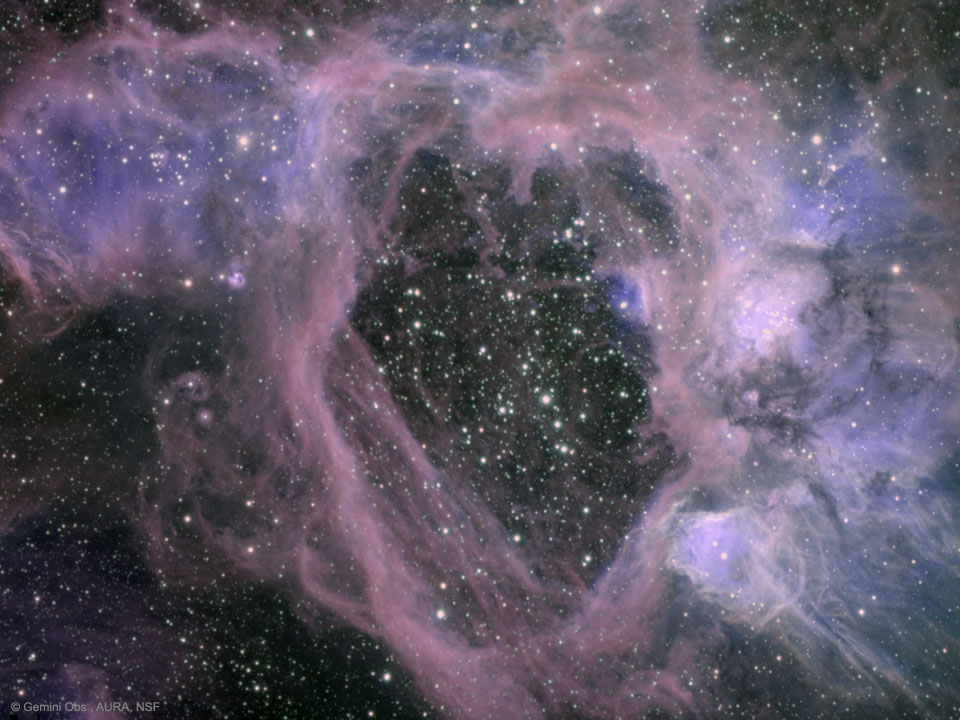
What created this gigantic hole? The vast emission nebula N44 in our neighboring galaxy the Large Magellanic Cloud has a large, 250 light-year hole and astronomers are trying to figure out why. One possibility is particle winds expelled by massive stars in the bubble's interior that are pushing out the glowing gas. This answer was found to be inconsistent with measured wind velocities, however. Another possibility is that the expanding shells of old supernovas have sculpted the unusual space cavern. An unexpected clue of hot X-ray emitting gas was recently been detected escaping the N44 superbubble. The featured image was taken in three very specific colors by the huge 8-meter Gemini South Telescope on Cerro Pachon in Chile. via NASA http://ift.tt/2t1javD
Final: Mets 5 Giants 2. WP: NYM J deGrom (7-3) LP: SF S Dyson (1-7) (ESPN)
from ESPN http://ift.tt/1dPqUAn
Final: Mets 11 Giants 4. WP: NYM S Lugo (2-1) LP: SF T Blach (4-5) (ESPN)
from ESPN http://ift.tt/1dPqUAn
Hubble Uses Gravitational Lens to Capture Disk Galaxy

By combining the power of a "natural lens" in space with the capability of NASA's Hubble Space Telescope, astronomers made a surprising discovery—the first example of a compact yet massive, fast-spinning, disk-shaped galaxy that stopped making stars only a few billion years after the big bang. via NASA http://ift.tt/2t2PLCd
Solstice Conjunction over Budapest
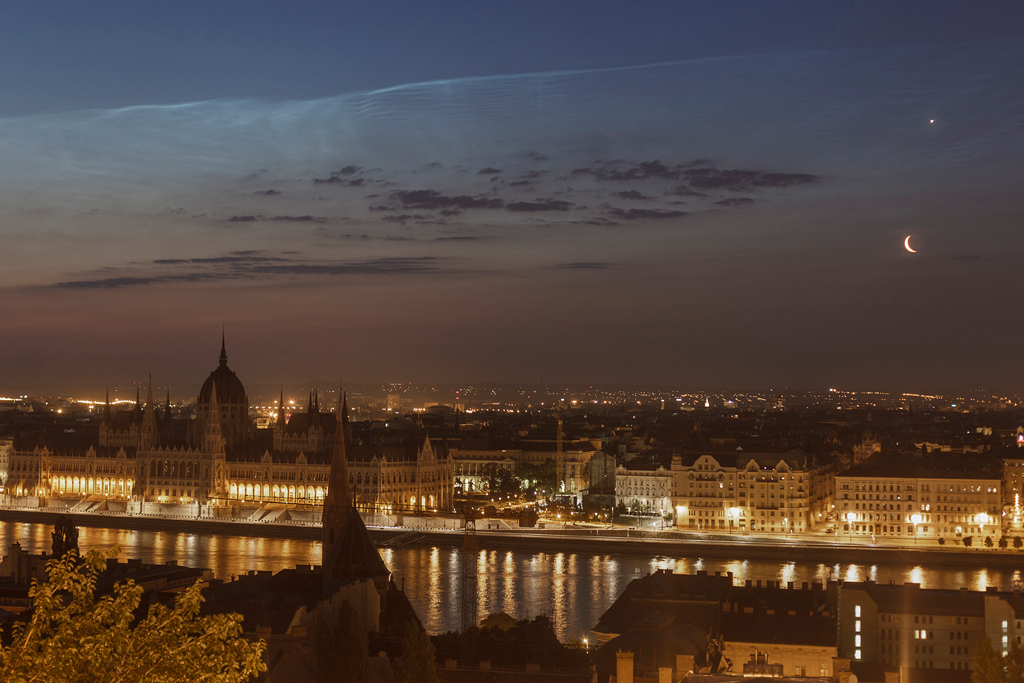
Before a solstice Sun rose on June 21, brilliant Venus and an old crescent Moon posed together over Budapest, Hungary for this predawn skyscape. In the foreground the view looks across the Danube river from Buda to Pest toward the dome and peaks of the Hungarian Parliament building. Low clouds are in silhouette against a twilight sky. But far enough above the eastern horizon to catch the sunlight shines another seasonal apparition on that solstice morning, noctilucent clouds. Seen near sunrise and sunset in summer months at high latitudes, the night-shining clouds are formed as water vapor in the cold upper atmosphere condenses on meteoric dust or volcanic ash near the edge of space. via NASA http://ift.tt/2sSU41V
The White Cliffs of 'Rover'

This image was acquired by the High Resolution Imaging Science Experiment (HiRISE) camera aboard NASA's Mars Reconnaissance Orbiter on April 18, 2017, at 14:04 local Mars time. It reminded the HiRISE team of the rugged and open terrain of a stark shore-line, perhaps of the British Isles. via NASA http://ift.tt/2rGyUke
Northern Summer on Titan
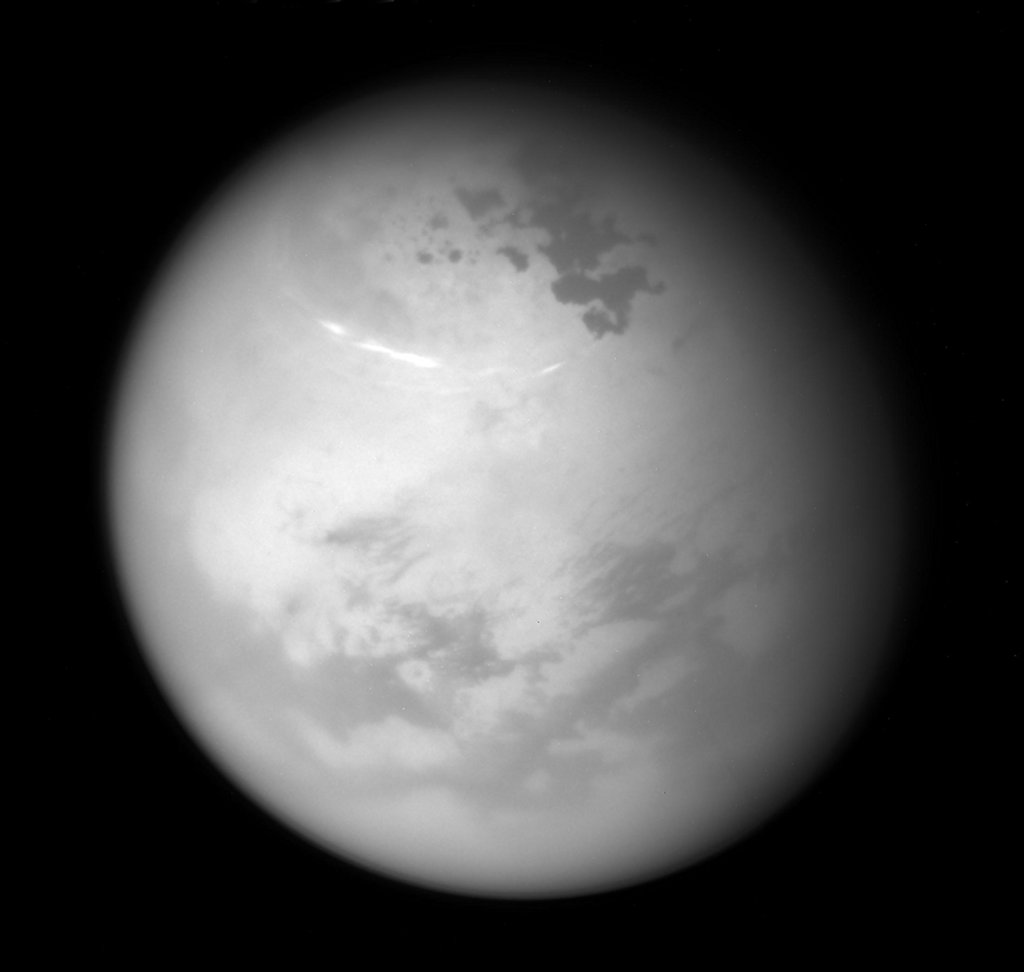
While yesterday's solstice brought summer to planet Earth's northern hemisphere, a northern summer solstice arrived for ringed planet Saturn nearly a month ago on May 24. Following the Saturnian seasons, its large moon Titan was captured in this Cassini spacecraft image from June 9. The near-infrared view finds bright methane clouds drifting through Titan's northern summer skies as seen from a distance of about 507,000 kilometers. Below Titan's clouds, dark hydrocarbon lakes sprawl near the large moon's now illuminated north pole. via NASA http://ift.tt/2sRQmGr
F/11: Braves 5 Giants 3. WP: ATL L Jackson (2-0) LP: SF C Gearrin (1-2) (ESPN)
from ESPN http://ift.tt/1dPqUAn
Visualization of the August 21, 2017 Total Solar Eclipse

On August 21, 2017, the Earth will cross the shadow of the moon, creating a total solar eclipse. Eclipses happen about every six months, but this one is special. For the first time in almost 40 years, the path of the moon's shadow passes through the continental United States. via NASA http://ift.tt/2rRirhl
A Sundial that Shows Solstice
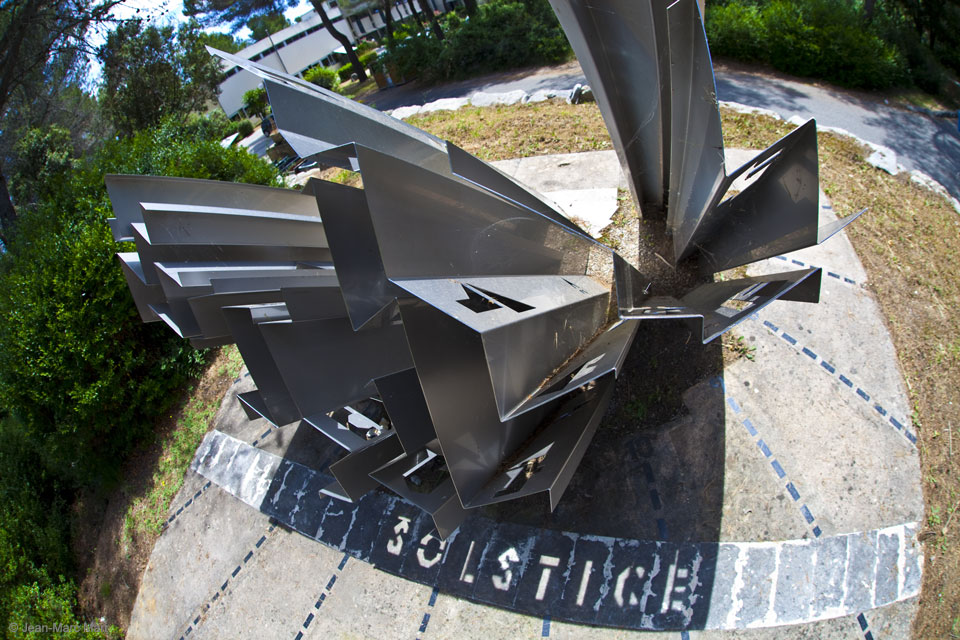
What day is it? If the day -- and time -- are right, this sundial will tell you: SOLSTICE. Only then will our Sun be located just right for sunlight to stream through openings and spell out the term for the longest and shortest days of the year. But this will happen today (and again in December). The sundial was constructed by Jean Salins in 1980 and is situated at the Ecole Supérieure des Mines de Paris in Valbonne Sophia Antipolis of south-eastern France. On two other days of the year, watchers of this sundial might get to see it produce another word: EQUINOXE. via NASA http://ift.tt/2rz8BMB
Deployment of the Space Station's Roll Out Solar Array Experiment

Over the weekend of June 17-18, engineers on the ground remotely operated the International Space Station's Canadarm2 to extract the Roll Out Solar Array experiment from the SpaceX Dragon resupply ship. The experiment will remain attached to the Canadarm2 over seven days to test this advanced, flexible array that rolls out like a tape measure. via NASA http://ift.tt/2tp28oW
The Massive Stars in Westerlund 1
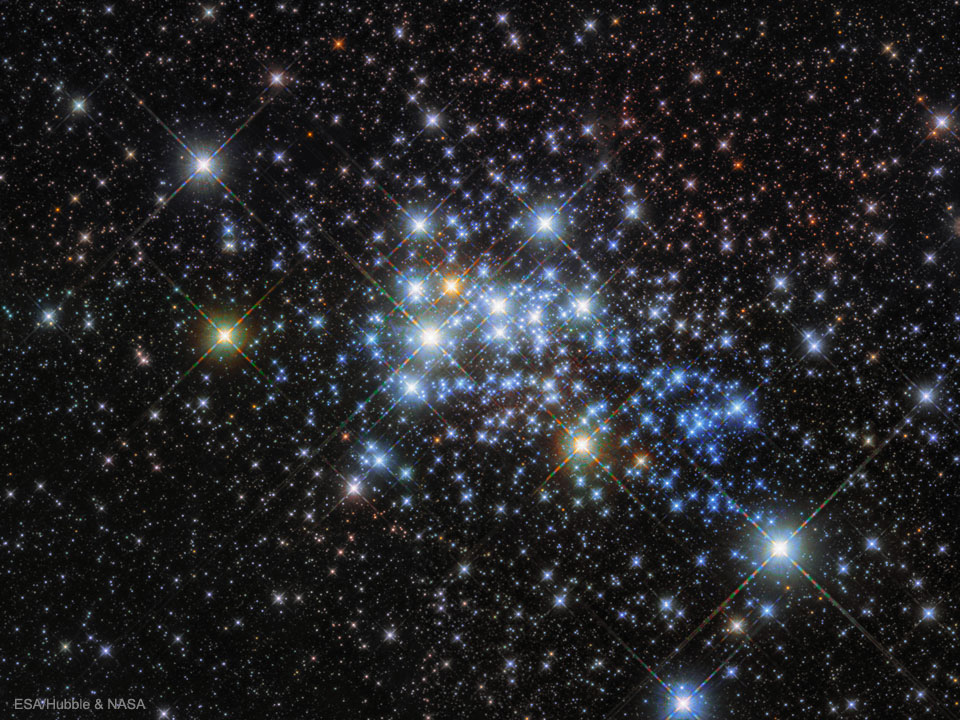
Star cluster Westerlund 1 is home to some of the largest and most massive stars known. It is headlined by the star Westerlund 1-26, a red supergiant star so big that if placed in the center of our Solar System, it would extend out past the orbit of Jupiter. Additionally, the young star cluster is home to 3 other red supergiants, 6 yellow hypergiant stars, 24 Wolf-Rayet stars, and several even-more unusual stars that continue to be studied. Westerlund 1 is relatively close-by for a star cluster at a distance of 15,000 light years, giving astronomers a good laboratory to study the development of massive stars. The featured image of Westerlund 1 was taken by the Hubble Space Telescope toward the southern constellation of the Altar (Ara). Although presently classified as a "super" open cluster, Westerlund 1 may evolve into a low mass globular cluster over the next billion years. via NASA http://ift.tt/2rvPUJT
Final: Braves 9 Giants 0. WP: ATL R Dickey (5-5) LP: SF J Cueto (5-7) (ESPN)
from ESPN http://ift.tt/1dPqUAn
Webb Telescope Set for Testing in Space Simulation Chamber

NASA’s James Webb Space Telescope sits in front of the door to Chamber A, a giant thermal vacuum chamber located at NASA’s Johnson Space Center. The telescope will soon be moved into the chamber, where it will spend a hot Houston summer undergoing tests at sub-freezing cryogenic temperatures. via NASA http://ift.tt/2sKRZWE
Final: Rockies 7 Giants 5. WP: COL C Estevez (4-0) LP: SF M Melancon (1-2) (ESPN)
from ESPN http://ift.tt/1dPqUAn
Final: Rockies 5 Giants 1. WP: COL K Freeland (8-4) LP: SF M Cain (3-6) (ESPN)
from ESPN http://ift.tt/1dPqUAn
Saturn near Opposition
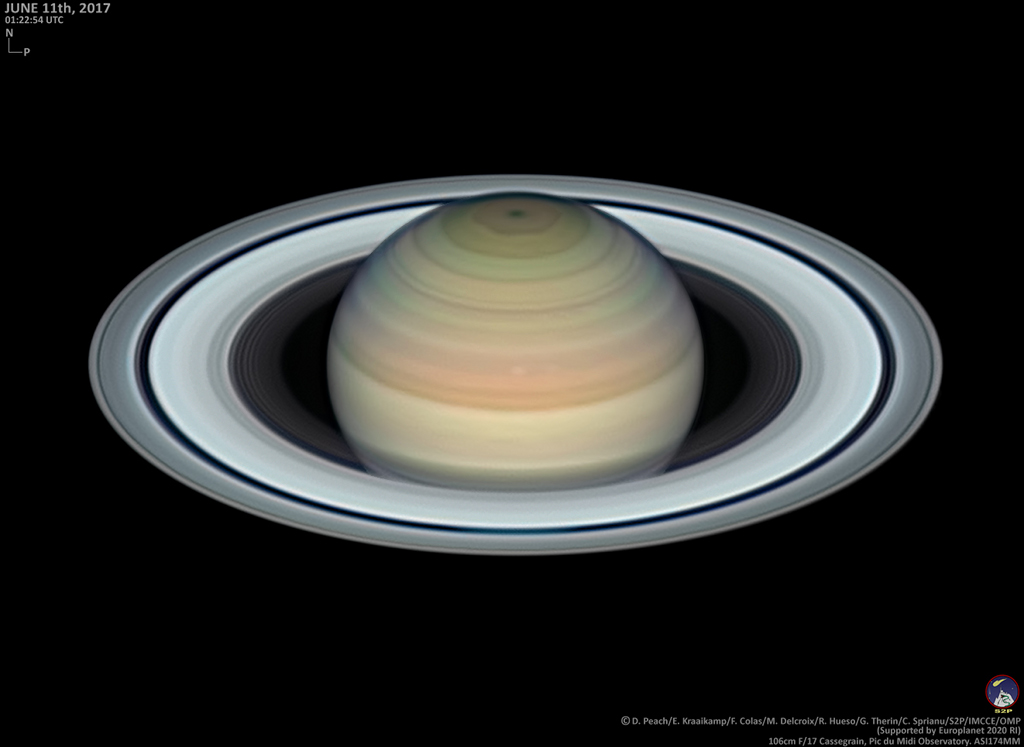
Saturn reached its 2017 opposition on June 16. Of course, opposition means opposite the Sun in Earth's sky and near opposition Saturn is up all night, at its closest and brightest for the year. This remarkably sharp image of the ringed planet was taken only days before, on June 11, with a 1-meter telescope from the mountain top Pic du Midi observatory. North is at the top with the giant planet's north polar storm and curious hexagon clearly seen bathed in sunlight. But Saturn's spectacular ring system is also shown in stunning detail. The narrow Encke division is visible around the entire outer A ring, small ringlets can be traced within the fainter inner C ring, and Saturn's southern hemisphere can be glimpsed through the wider Cassini division. Near opposition Saturn's rings also appear exceptionally bright, known as the opposition surge or Seeliger Effect. Directly illuminated from Earth's perspective, the ring's icy particles cast no shadows and strongly backscatter sunlight creating the dramatic increase in brightness. Still, the best views of the ringed planet are currently from the Saturn-orbiting Cassini spacecraft. Diving close, Cassini's Grand Finale orbit number 9 is in progress. via NASA http://ift.tt/2rmLBAm
Final: Rockies 10 Giants 8. WP: COL A Senzatela (9-2) LP: SF J Samardzija (2-9) (ESPN)
from ESPN http://ift.tt/1dPqUAn
Jupiter’s Clouds of Many Colors

NASA’s Juno spacecraft was racing away from Jupiter following its seventh close pass of the planet when JunoCam snapped this image on May 19, 2017, from about 29,100 miles (46,900 kilometers) above the cloud tops. via NASA http://ift.tt/2s9872E
Manhattan Moonrise

A Full Moon rose as the Sun set on June 9, known to some as a Strawberry Moon. Close to the horizon and taking on the warm color of reflected sunlight filtered through a dense and dusty atmosphere, the fully illuminated lunar disk poses with the skyscrapers along the southern Manhattan skyline in this telephoto snapshot. The picture was taken from Eagle Rock Reservation, a park in West Orange, New Jersey, planet Earth. That's about 13 miles from southern Manhattan and some 240,000 miles from the Moon. Foreground faces of the modern towers of steel and glass share the Moon's warm color by reflecting the last rays of the setting Sun. The tallest, with the shining triangular facet, is New York City's One World Trade center. via NASA http://ift.tt/2t4zRDR
Giants Video: Buster Posey limps off after injuring ankle while hitting a homer (ESPN)
from ESPN http://ift.tt/1dPqUAn
Final: Rockies 10 Giants 9. WP: COL G Holland (1-0) LP: SF H Strickland (1-2) (ESPN)
from ESPN http://ift.tt/1dPqUAn
Northern Summer on Titan

NASA's Cassini spacecraft sees bright methane clouds drifting in the summer skies of Saturn's moon Titan, along with dark hydrocarbon lakes and seas clustered around the north pole. via NASA http://ift.tt/2sw5OYV
Red Sprites over the Channel
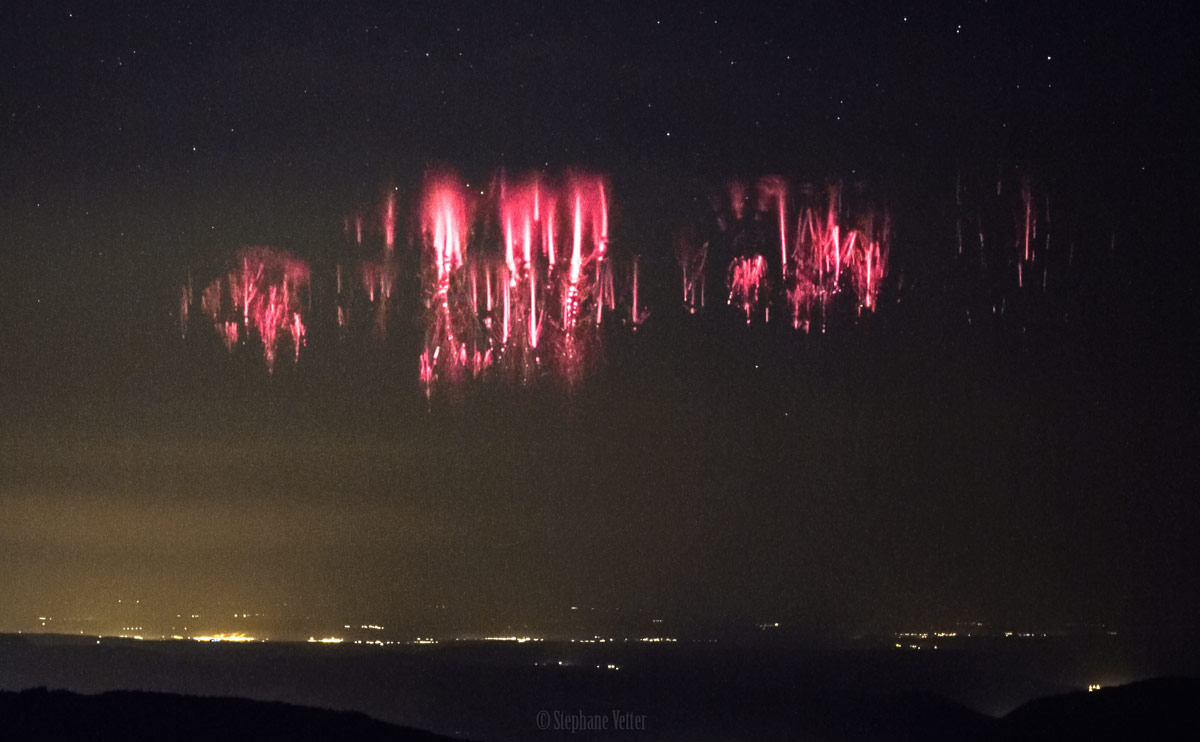
Mysterious and incredibly brief, red sprites are seen to occur high above large thunderstorms on planet Earth. While they have been recorded from low Earth orbit or high flying airplanes, these dancing, lightning-like events were captured in video frames from a mountain top perch in northern France. Taken during the night of May 28, the remarkably clear, unobstructed view looks toward a multicell storm system raging over the English Channel about 600 kilometers away. Lasting only a few milliseconds, the red sprite association with thunderstorms is known. Still, much remains a mystery about the fleeting apparitions including the nature of their relation to other upper atmospheric lightning phenomena such as blue jets or satellite detected terrestrial gamma flashes. via NASA http://ift.tt/2rvwGmB
Final: Royals 7 Giants 2. WP: KC J Hammel (3-6) LP: SF J Cueto (5-6) (ESPN)
from ESPN http://ift.tt/1dPqUAn
Celebrating Flag Day

NASA astronaut Jack Fischer took this photograph of an American flag in one of the windows of the International Space Station's cupola, a dome-shaped module through which operations on the outside of the station can be observed and guided. Throughout NASA's history, spacecraft and launch vehicles have always been decorated with flags. via NASA http://ift.tt/2rsJ3EW
M89: Elliptical Galaxy with Outer Shells and Plumes
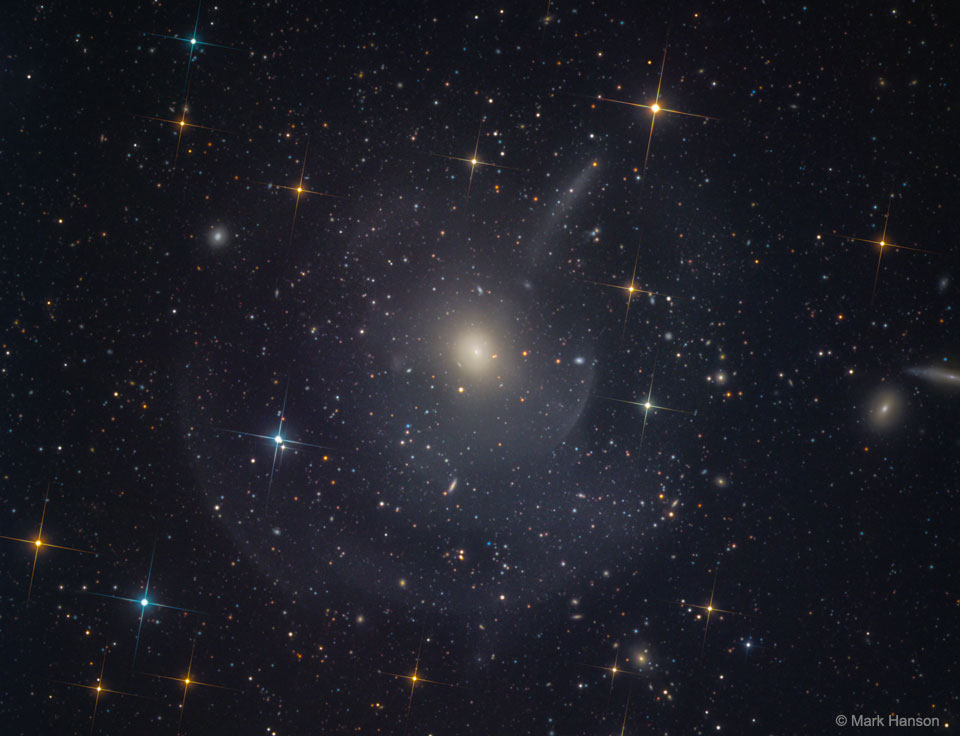
Can you see them? This famous Messier object M89, a seemingly simple elliptical galaxy, is surrounded by faint shells and plumes. The cause of the shells is currently unknown, but possibly tidal tails related to debris left over from absorbing numerous small galaxies in the past billion years. Alternatively the shells may be like ripples in a pond, where a recent collision with another large galaxy created density waves that ripple through this galactic giant. Regardless of the actual cause, the featured image highlights the increasing consensus that at least some elliptical galaxies have formed in the recent past, and that the outer halos of most large galaxies are not really smooth but have complexities induced by frequent interactions with -- and accretions of -- smaller nearby galaxies. The halo of our own Milky Way Galaxy is one example of such unexpected complexity. M89 is a member of the nearby Virgo cluster of galaxies which lies about 50 million light years distant. via NASA http://ift.tt/2smPVUD
Final: Royals 8 Giants 1. WP: KC J Vargas (9-3) LP: SF T Blach (4-4) (ESPN)
from ESPN http://ift.tt/1dPqUAn
Illustration of Cool Dust Around an Active Black Hole

This artist illustration shows the thick ring of dust that can obscure the energetic processes that occur near the supermassive black hole of an active galactic nuclei. Researchers have found that the dust surrounding active, ravenous black holes is much more compact than previously thought. via NASA http://ift.tt/2sxGp0k
Turquoise Swirls in the Black Sea

On May 29, 2017, the Moderate Resolution Imaging Spectroradiometer (MODIS) on NASA’s Aqua satellite captured the data for this image of an ongoing phytoplankton bloom in the Black Sea. The image is a mosaic, composed from multiple satellite passes over the region. via NASA http://ift.tt/2sl9b4F
An Unusual Hole in Mars
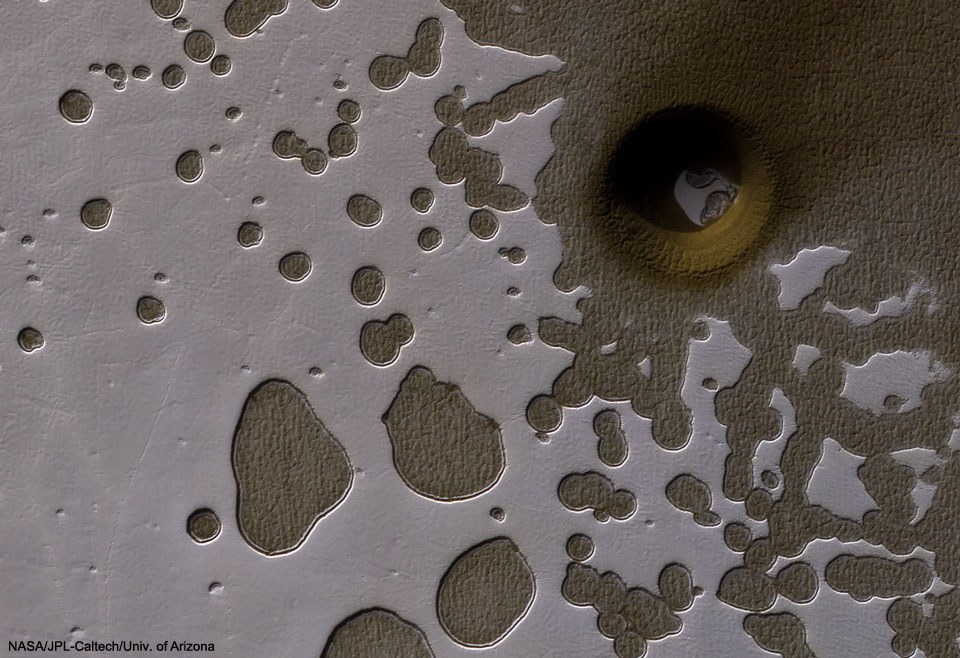
What created this unusual hole in Mars? Actually, there are numerous holes pictured in this Swiss cheese-like landscape, with all-but-one of them showing a dusty, dark, Martian terrain beneath evaporating, light, carbon-dioxide ice. The most unusual hole is on the upper right, spans about 100-meters, and seems to punch through to a lower level. Why this hole exists and why it is surrounded by a circular crater remains a topic of speculation, although a leading hypothesis is that it was created by a meteor impact. Holes such as this are of particular interest because they might be portals to lower levels that extend into expansive underground caves. If so, these naturally-occurring tunnels are relatively protected from the harsh surface of Mars, making them relatively good candidates to contain Martian life. These pits are therefore prime targets for possible future spacecraft, robots, and even human interplanetary explorers. via NASA http://ift.tt/2rYV6qA
Final: Giants 13 Twins 8. WP: SF J Osich (1-1) LP: MIN M Belisle (0-1) (ESPN)
from ESPN http://ift.tt/1dPqUAn
IC 418: The Spirograph Nebula

What is creating the strange texture of IC 418? Dubbed the Spirograph Nebula for its resemblance to drawings from a cyclical drawing tool, planetary nebula IC 418 shows patterns that are not well understood. Perhaps they are related to chaotic winds from the variable central star, which changes brightness unpredictably in just a few hours. By contrast, evidence indicates that only a few million years ago, IC 418 was probably a well-understood star similar to our Sun. Only a few thousand years ago, IC 418 was probably a common red giant star. Since running out of nuclear fuel, though, the outer envelope has begun expanding outward leaving a hot remnant core destined to become a white-dwarf star, visible in the image center. The light from the central core excites surrounding atoms in the nebula causing them to glow. IC 418 lies about 2000 light-years away and spans 0.3 light-years across. This false-color image taken from the Hubble Space Telescope reveals the unusual details. via NASA http://ift.tt/2r4wFqu
Saturn in the Milky Way
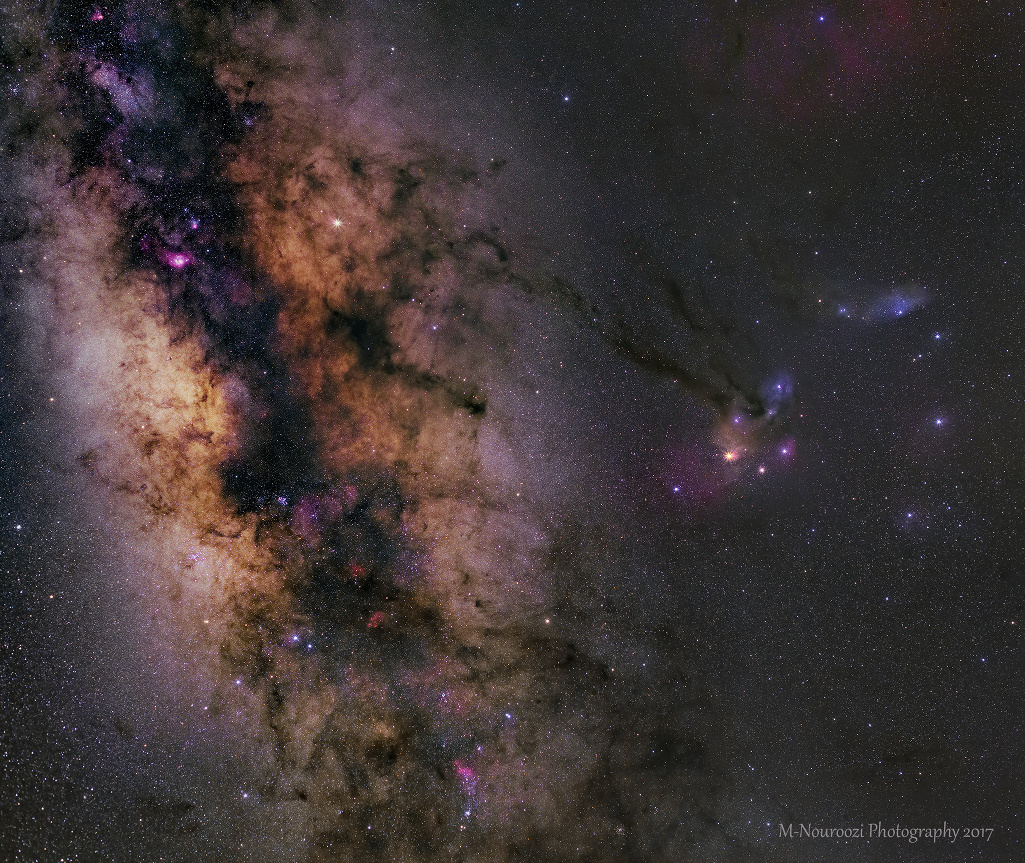
Saturn is near opposition in planet Earth's sky. Rising at sunset and shining brightly throughout the night, it also lies near a line-of-sight to crowded starfields, nebulae, and obscuring dust clouds along the Milky Way. Whitish Saturn is up and left of center in this gorgeous central Milky Way skyscape, a two panel mosaic recorded earlier this month. You can find the bright planet above the bowl of the dusty Pipe nebula, and just beyond the end of a dark river to Antares, alpha star of the constellation Scorpius. For now the best views of the ringed giant planet are from the Saturn-orbiting Cassini spacecraft, though. Diving close, Cassini's Grand Finale orbit number 8 is in progress. via NASA http://ift.tt/2sJ7ECt
Final: Twins 4 Giants 0. WP: MIN E Santana (8-3) LP: SF M Moore (2-7) (ESPN)
from ESPN http://ift.tt/1dPqUAn
Pongal Catena on Ceres

This image from NASA's Dawn spacecraft shows the northeastern rim of Urvara Crater on Ceres. via NASA http://ift.tt/2s50Q4c
M27 Not a Comet

While hunting for comets in the skies above 18th century France, astronomer Charles Messier diligently kept a list of the things he encountered that were definitely not comets. This is number 27 on his now famous not-a-comet list. In fact, 21st century astronomers would identify it as a planetary nebula, but it's not a planet either, even though it may appear round and planet-like in a small telescope. Messier 27 (M27) is an excellent example of a gaseous emission nebula created as a sun-like star runs out of nuclear fuel in its core. The nebula forms as the star's outer layers are expelled into space, with a visible glow generated by atoms excited by the dying star's intense but invisible ultraviolet light. Known by the popular name of the Dumbbell Nebula, the beautifully symmetric interstellar gas cloud is over 2.5 light-years across and about 1,200 light-years away in the constellation Vulpecula. This spectacular color image incorporates broad and narrowband observations recorded by the 8.2 meter Subaru telescope. via NASA http://ift.tt/2rXPe38
Watching a Volatile Stellar Relationship

In biology, “symbiosis” refers to two organisms that live close to and interact with one another. Astronomers have long studied a class of stars – called symbiotic stars – that co-exist in a similar way. Astronomers are gaining a better understanding of how volatile this close stellar relationship can be. via NASA http://ift.tt/2rI8dMJ
F/10: Giants 9 Brewers 5. WP: SF M Melancon (1-1) LP: MIL J Barnes (1-1) (ESPN)
from ESPN http://ift.tt/1dPqUAn
Firefall by Moonlight

On certain dates in February, an elusive firefall can be spotted at sunset in Yosemite National Park, when the weather cooperates and the direction to the setting Sun is just right. Often photographed from vantage points below, at the right moment the park's seasonal Horsetail Fall is isolated in the shadows of the steep walls of El Capitan but still illuminated with rays of sunlight reflected by the angled rockface directly behind the flow, briefly giving the waterfall a dramatic fiery appearance. The Horsetail firefall is more rarely photographed at moonset under a starry night sky, though. Even more elusive by moonlight, the firefall effect can also be seen when skies are clear and a bright Moon sets at the right direction along the western horizon. Skies were clear and stars were shining for this well-planned photograph of the Horsetail firefall lit by a gibbous Moon setting in the early morning hours of May 9. via NASA http://ift.tt/2rUN2ZT
Final: Brewers 6 Giants 3. WP: MIL J Nelson (4-3) LP: SF T Blach (4-3) (ESPN)
from ESPN http://ift.tt/1dPqUAn
NASA's 2017 Astronaut Candidates

NASA's 2017 astronaut candidates take a group photo at Ellington Field near Johnson Space Center. Pictured are, front row, left to right, Zena Cardman, Jasmin Moghbeli, Robb Kulin, Jessica Watkins, Loral O'Hara; back row, left to right, Jonny Kim, Frank Rubio, Matthew Dominick, Warren Hoburg, Kayla Barron, Bob Hines, and Raja Chari. via NASA http://ift.tt/2sE8SPl
An Astronaut's View From the 'Corner Office'

NASA astronaut Jack Fischer tweeted this photograph from the International Space Station on June 3, 2017, writing, "Never had a corner office with a view, but I must admit, I like it… a lot! #SpaceRocks." Fischer, a member of the 2009 astronaut class, has been living and working aboard the orbiting laboratory since April 20, 2017. via NASA http://ift.tt/2rQJJmL
The Case of the Missing Star
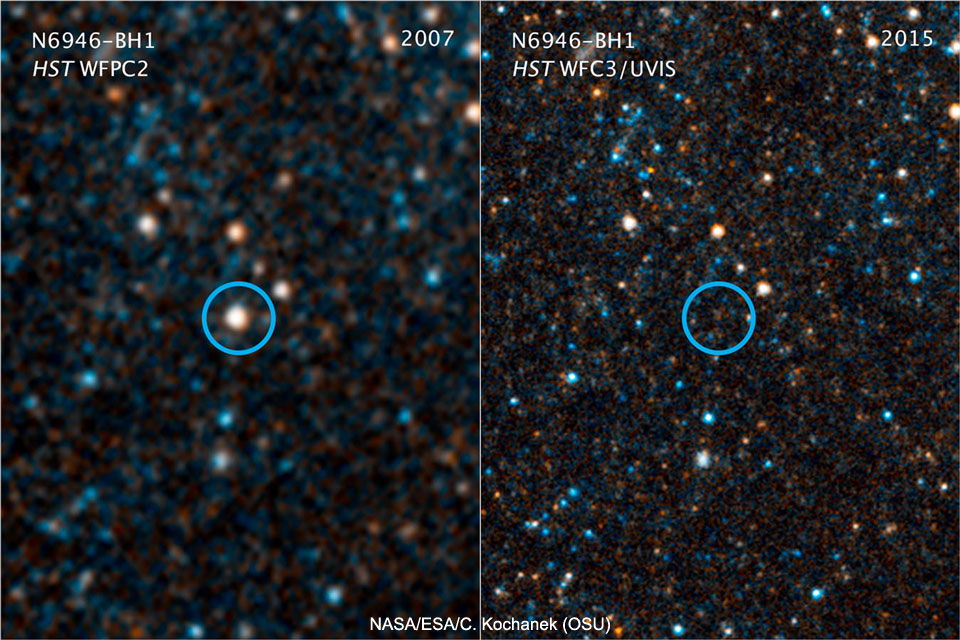
What's happened to giant star N6946-BH1? It was there just a few years ago -- Hubble imaged it. Now there's only a faint glow. What's curiouser, no bright supernova occurred -- although the star did brightened significantly for a few months. The leading theory is that, at about 25 times the mass of our Sun, N6946-BH1's great gravity held much of the star together during its final tumultuous death throes, after which most the star sunk into a black hole of its own making. If so, then what remained outside of the black hole likely then formed an accretion disk that emits comparatively faint infrared light as it swirls around, before falling in. If this mode of star death is confirmed with other stars, it gives direct evidence that a very massive star can end its life with a whimper rather than a bang. via NASA http://ift.tt/2rCQc2l
Final: Giants 7 Brewers 2. WP: SF J Samardzija (2-7) LP: MIL R Scahill (1-2) (ESPN)
from ESPN http://ift.tt/1dPqUAn
Mimas Dwarfed

From high above Saturn's northern hemisphere, NASA's Cassini spacecraft gazes over the planet's north pole, with its intriguing hexagon and bullseye-like central vortex. via NASA http://ift.tt/2qUdTGt
Highlights of the Summer Sky
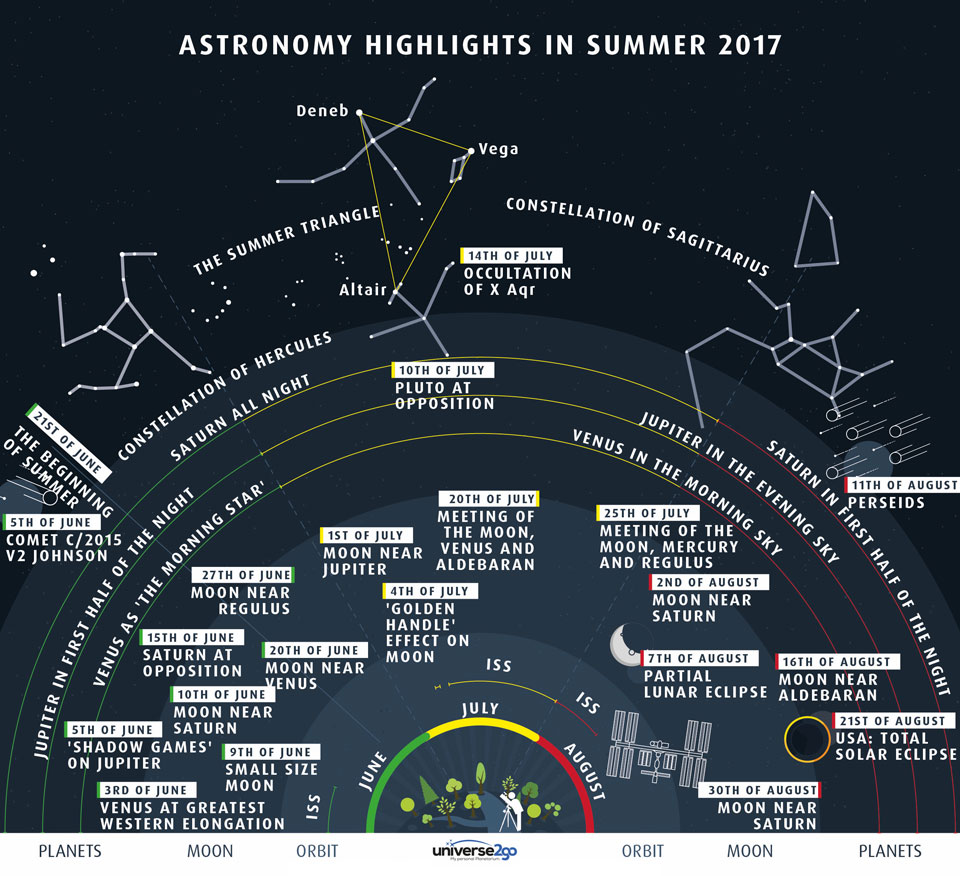
What's up in the sky this summer? The featured graphic gives a few highlights for Earth's northern hemisphere. Viewed as a clock face centered at the bottom, early summer sky events fan out toward the left, while late summer events are projected toward the right. Objects relatively close to Earth are illustrated, in general, as nearer to the cartoon figure with the telescope at the bottom center -- although almost everything pictured can be seen without a telescope. Highlights of this summer's sky include that Jupiter will be visible after sunset during June, while Saturn will be visible after sunset during August. A close grouping of the Moon, Venus and the bright star Aldebaran will occur during mid-July. In early August, the Perseids meteor shower peaks. Surely the most famous pending astronomical event occurring this summer, though, will be a total eclipse of the Sun visible over a thin cloud-free swath across the USA on 21 August. via NASA http://ift.tt/2srBATl
Orion: Belt, Flame, and Horsehead

What surrounds the famous belt stars of Orion? A deep exposure shows everything from dark nebula to star clusters, all embedded in an extended patch of gaseous wisps in the greater Orion Molecular Cloud Complex. The brightest three stars, appearing diagonally on the left of the featured image are indeed the famous three stars that make up the belt of Orion. Just below Alnitak, the lowest of the three belt stars, is the Flame Nebula, glowing with excited hydrogen gas and immersed in filaments of dark brown dust. Just to the right of Alnitak lies the Horsehead Nebula, a dark indentation of dense dust that has perhaps the most recognized nebular shapes on the sky. The dark molecular cloud, roughly 1,500 light years distant, is cataloged as Barnard 33 and is seen primarily because it is backlit by the nearby massive star Sigma Orionis. The Horsehead Nebula will slowly shift its apparent shape over the next few million years and will eventually be destroyed by the high-energy starlight. via NASA http://ift.tt/2rPuLy7
SpaceX CRS-11 Cargo Mission Launch

The SpaceX Falcon 9 rocket, with the Dragon spacecraft onboard, launches from pad 39A at NASA’s Kennedy Space Center in Cape Canaveral, Florida, Saturday, June 3, 2017. via NASA http://ift.tt/2rEbNcK
Final: Phillies 5 Giants 3. WP: PHI B Lively (1-0) LP: SF J Cueto (5-5) (ESPN)
from ESPN http://ift.tt/1dPqUAn
Perijove Passage

On May 19, the Juno spacecraft once again swung by Jupiter in its looping 53 day orbit around the Solar System's ruling gas gaint. Beginning at the top, this vertical 14 frame sequence of enhanced-color JunoCam images follows the spacecraft's rapidly changing perspective during its two hour passage. They look down on Jupiter's north polar region, equatorial, and south polar region (bottom images). With the field-of-view shrinking, the seventh and eighth images in the sequence are close-up. Taken only 4 minutes apart above Jupiter's equator they were captured just before the spacecraft reached perijove 6, its closest approach to Jupiter on this orbit. Final images in the sequence pick up white oval storm systems, Jupiter's "String of Pearls", and the south polar region from the outward bound spacecraft. via NASA http://ift.tt/2rLehHf
Final: Giants 10 Phillies 0. WP: SF T Blach (4-2) LP: PHI J Eickhoff (0-6) (ESPN)
from ESPN http://ift.tt/1dPqUAn
A South Polar Pit or an Impact Crater?

This observation from NASA's Mars Reconnaissance Orbiter show it is late summer in the Southern hemisphere, so the Sun is low in the sky and subtle topography is accentuated in orbital images. via NASA http://ift.tt/2s25Hnd
Black Holes of Known Mass
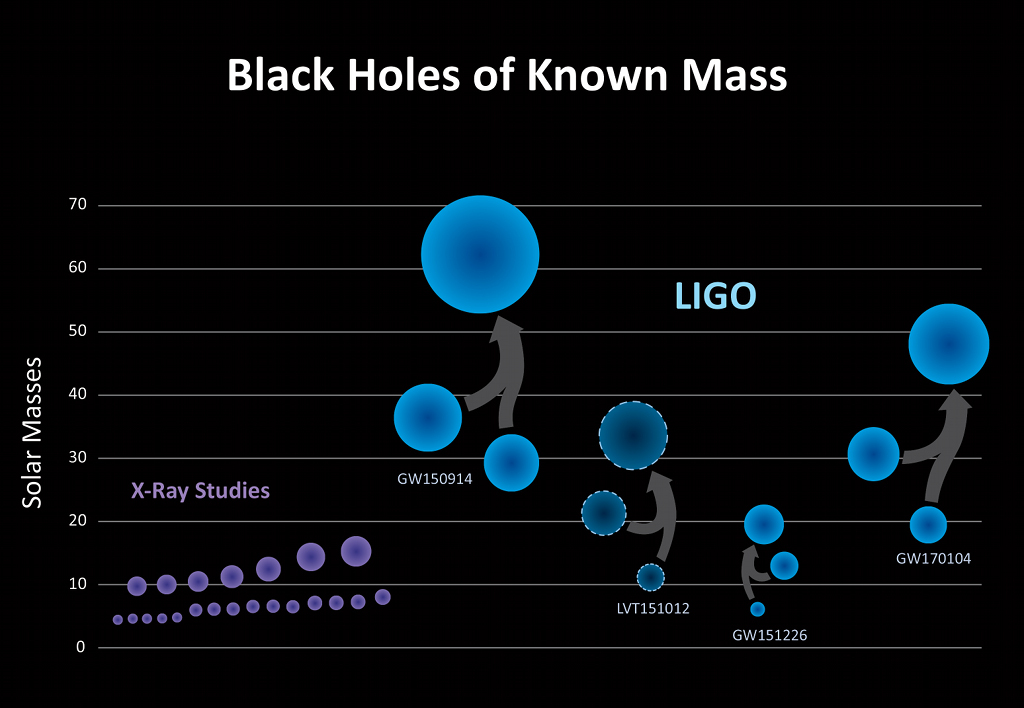
Add GW170104 to the chart of black holes with known mass. The extremely energetic merger of two smaller black holes corresponds to the Laser Interferometer Gravitational-wave Observatory's (LIGO) third detection of gravitational waves. The newfound black hole has a mass about 49 times that of the Sun, filling a gap between the masses of the two merged black holes detected previously by LIGO, with solar masses of 62 (GW150914) and 21 (GW151216). In all three cases, the signal in each of the twin LIGO detectors was unambiguously identified as coming from black hole mergers while a fourth case (LVT151012) resulted in a lower confidence detection. GW170104 is estimated to be some 3 billion light-years away, more distant than present estimates for GW150914 and GW151216. The ripples in spacetime were discovered during LIGO's current observing run, which began November 30, 2016 and will continue through the summer. via NASA http://ift.tt/2ron3b5
Eleventh SpaceX Commercial Resupply Mission to Space Station Set for Launch

The SpaceX Falcon 9 rocket, with the Dragon spacecraft onboard, is seen shortly after being raised vertical at Launch Complex 39A at NASA’s Kennedy Space Center in Cape Canaveral, Florida, Thursday, June 1, 2017. Liftoff is scheduled for 5:55 p.m EDT. via NASA http://ift.tt/2sitxbp
Subscribe to:
Posts (Atom)